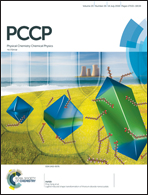The confined [Bmim][BF4] ionic liquid flow through graphene oxide nanochannels: a molecular dynamics study†
Abstract
Ionic liquid (IL) flow in graphene oxide (GO) nanochannels plays a key role in the performance of IL- and GO-based fluidics devices and other chemical separator techniques. Here, we investigate the flow behavior of ILs in GO nanochannels via molecular dynamics simulations. The quantitative relation between slip velocity and shear stress has been identified, showing that the interfacial friction coefficient can be enhanced by almost sixty times, while the slip length is reduced by about three orders of magnitude, with the fraction of hydroxylation in graphene ranging from 0% to 15%. The great change in interfacial properties can be attributed to the structural changes of IL layers near GO, which is proved by the detailed analysis of density distribution, charge distribution and radial distribution function. Besides, the viscosity will increase as a fraction of hydroxylation because of the partial breaking of coulombic ordering of confined ILs. Meanwhile, the hydroxyls have more significant effects on IL flow than water flow in GO nanochannels due to the stronger interaction networks in IL/GO interfaces. In summary, hydroxylation can be a convincing method to regulate the IL flow in nanochannels. The quantitative properties of confined ILs in GO nanochannels and their relation to the fraction of hydroxylation could deepen the understanding of ILs and benefit the applications of ILs and GO in the fields of chemical engineering and various other nanofluidic devices.
![Graphical abstract: The confined [Bmim][BF4] ionic liquid flow through graphene oxide nanochannels: a molecular dynamics study](/en/Image/Get?imageInfo.ImageType=GA&imageInfo.ImageIdentifier.ManuscriptID=C8CP02408A&imageInfo.ImageIdentifier.Year=2018)


 Please wait while we load your content...
Please wait while we load your content...